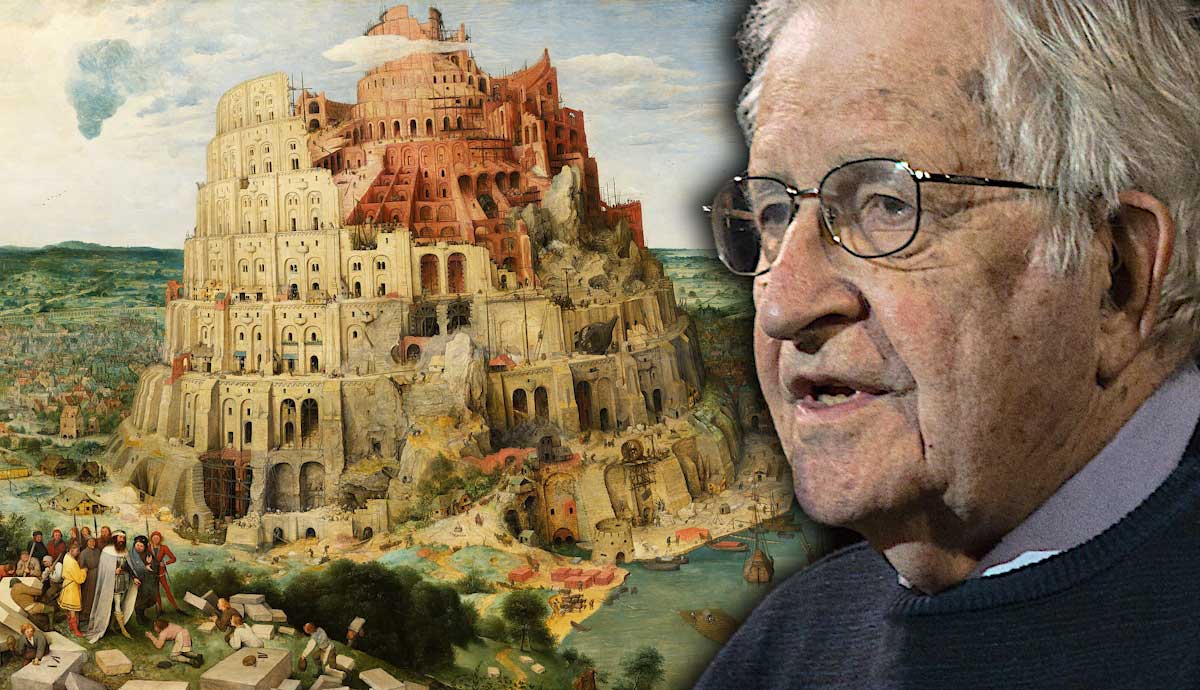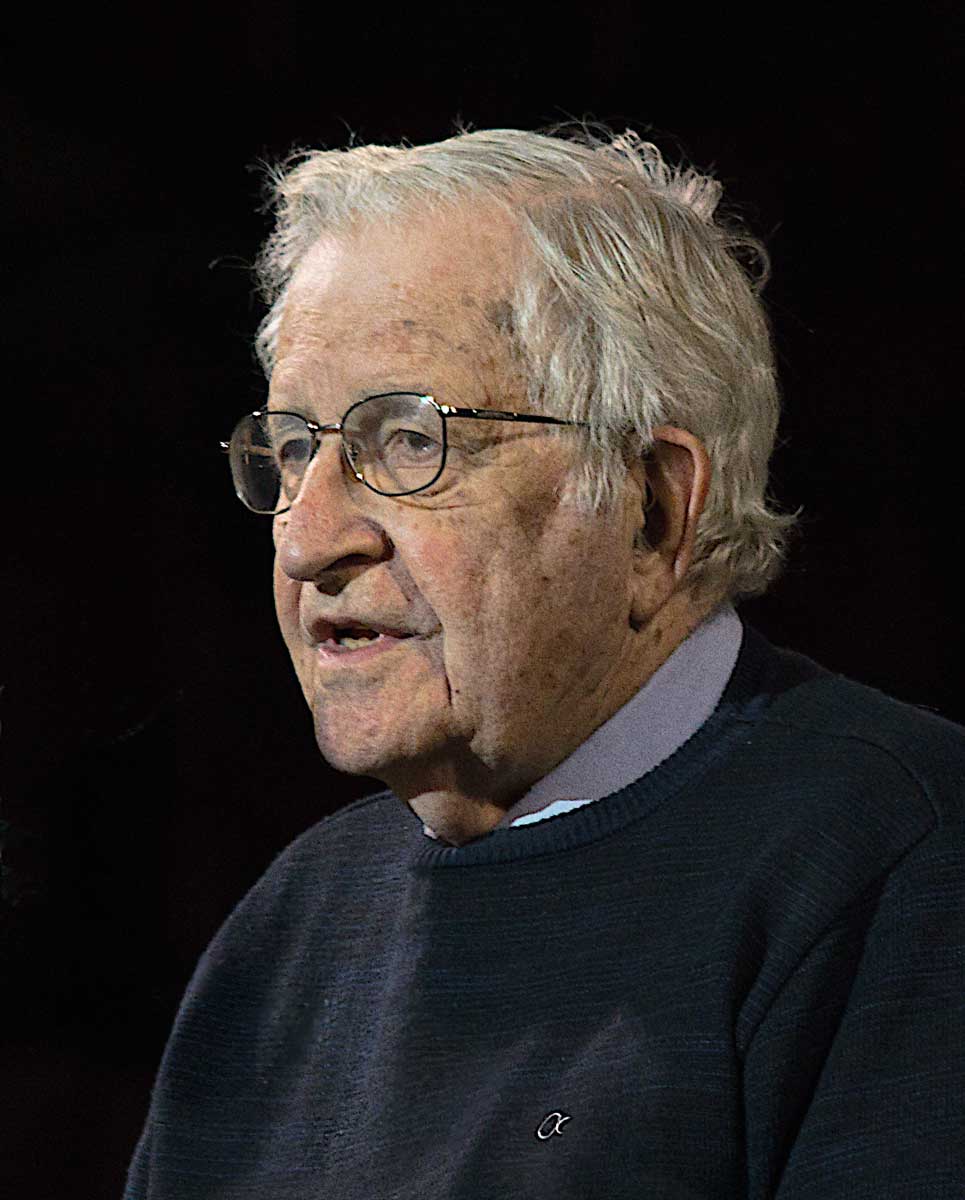
Chomsky is, undoubtedly, the most important linguist of all time, in part because his answer (or, answers) to that question has proven so profoundly influential.
Chomsky has had an astonishingly long and varied career, and in no way can one article summarize over sixty years of focused research. All that this article aims to do is provide a general overview of Chomsky’s approach to language, give a sense of how his research program has developed over time, and reflect on the philosophical component of his work. It begins by explaining how linguistics and philosophy are related, both in general and in Chomsky’s work in particular. It then moves on to a brief historical overview, which sets out how Chomsky’s program has developed over the years. It finally considers a philosophical disagreement between Chomsky and Frege on the relationship between language and logic.
Philosophy and Linguistics

The philosophical importance of linguistics lies in the fact that certain areas of inquiry can plausibly be approached from a variety of directions. Many philosophers want to ask questions and solve problems related to the nature of language, and many philosophers are similarly interested in topics adjacent to that of language (communication, cognition and so on).
The best way to understand Chomsky’s work from a philosophical perspective is two-fold. First, his perspective on language is of interest to the philosophy of language. This is because Chomsky’s theory seeks to provide answers to most of the major questions which philosophers have about language, and has further indirect implications for other such questions. Chomsky himself was greatly influenced by some of the major philosophers of his day, in particular Austin and Quine, and undertook quite extensive research in philosophical logic as a young man. Second, Chomsky’s theory insofar as it claims to be a ‘scientific’ approach to language might be seen to provide some basic data for anyone wishing to build an accompanying philosophy of language. That is, at least, one conception of the relationship between science and philosophy.
The Concept of a Universal Grammar

Get the latest articles delivered to your inbox
Sign up to our Free Weekly Newsletter
Noam Chomsky is credited with developing the theory of Universal Grammar, or UG. The development of UG has taken place at two levels. On one level are the general ideas about language and language acquisition on which the theory is based. This involves the concepts of language competence, language performance and the innateness of language. On another level the theory includes an explanation of syntax, which is closely connected to historical and social context. In other words, there are shifts in the concepts of syntax, leading to a series of apparent discontinuities and changes of direction.
It is necessary to define some terms in order to properly understand Chomsky’s theory. First, language acquisition refers simply to how humans learn to speak the language they grow up speaking. Competence and performance are concepts which can be understood in terms of one another. Linguistic competence is, roughly, what one knows about one’s language, whereas performance is one’s practical ability to express oneself in it. Syntax can, for our purposes, be understood simply as the study of sentence structure.
The Phases of Chomsky’s Work

Chomsky’s research into language has moved through various phases. The original model, called Syntactic Structures, took its name from the title of Chomsky’s 1957 book, which established the notion of ‘generative grammar’ itself, with its emphasis on explicit ‘generative’, formal description.
This first theory distinguished between phrase structure rules that generated the basic structures of a language, called ‘kernel sentences’, and transformations which altered these in various ways by turning them into passive or negative sentences etc.; hence its popular name was ‘transformational generative grammar’ or ‘TGG’. Its most memorable product was the sentence, “Colourless green ideas sleep furiously”, which was intended to demonstrate that sentences could be grammatical but meaningless and hence that syntax is independent of semantics. Semantics is the study of meaning in language.

The theory of Transformational Generative Grammar was superseded by a new model first known as the Aspects Model after Chomsky’s 1965 book Aspects of the Theory of Syntax, later as the Standard Theory.
In this phase of his work, Chomsky introduced the idea of the competence/performance distinction between language knowledge and language use, for which the recognition of ‘deep’ and ‘surface’ structure in the sentence is important. Two classic test sentences used to exemplify this are (1) “John is eager to please”, which implies that John pleases other people, and (2) “John is easy to please” which implies that other people please John. The two sentences have the same surface structure but differ in deep structure, where “John” may act as the subject or object of the verb “please”.
This version of Chomsky’s theory then gave way to what is commonly called the ‘Government and Binding Model’, which introduced the concepts of principles and parameters. Principles are rules about language which are invariant across languages, while parameters determine the limited number of ways in which languages can vary.
There have been further stages since, involving (among other things) a rethinking of syntax and a renewed focus on vocabulary, but the basic motivation behind Chomsky’s work remains the simplification and (where necessary) amending or deletion of certain principles and parameters. In other words, his goal is to find which similarities we can find between languages are essential to it.
The Mind and Meaning

All of Chomsky’s theories attempt to give an account of what can be known about language, and how this knowledge is acquired. Chomsky has been very explicit in stating that his interest is not ultimately in language as such, but in the mind.
Language is treated as something in the mind of each individual human being, but this is not the whole extent of language; it is also understood to include certain physical things – written words, spoken sounds and other things which exist outside of the mind. The relationship between these two realms is and has long been the question about language.
As Chomsky puts it: “Each language can be regarded as a particular relationship between sounds and meaning”. Handling either realm on its own is generally easier and less controversial. According to Chomsky, the mind bridges this gap via a ‘computational system’, which links the sounds of language up with meanings in the speakers’ minds.

Chomsky’s more recent interests focus on things which happen on the edge of this computational system. On the one hand, there is the transformation of the internal forms of language used by the computational system into the more basic components of a language. In practice, this is the creation of sounds with our bodies by using what Chomsky refers to as the ‘sensorimotor system’.
On the other hand, there is the mind’s transformation of representations into mental concepts, using what Chomsky calls the “conceptual-intentional system”. The points of contact here are the interfaces between language knowledge, and the two areas which are not in and of themselves language: the external world of sounds and the internal world of concepts. For the computational system to work, it must have two ‘access’ systems: it must be able to interface at both points, because language needs both to be expressed, and it has to be integrated in the form of mental concepts.
Chomsky, Logic, and Frege

It should already be apparent how much of Chomsky’s theory of language touches on other major areas of philosophical inquiry, especially those to do with cognition and the mind.
Another major area of philosophy that is of personal interest to Chomsky is Logic. To explain why this is important, some connections between grammar and logic should be drawn here. Grammar, in linguistics context, is the whole knowledge of language in a person’s mind, not just the syntax (as we often use the word grammar to refer to).
Grammar must show both how the sentence is pronounced – as a sequence of sounds, stress patterns, intonation and so on – and what the sentence actually means – x is a proper name, y is a verb and so forth. As Vivian Cook and Mark Newson put it, “The linguist’s grammar thus needs a way of describing actual sounds a phonetic representation; it needs a way of representing meaning – a semantic representation; and it needs a way of describing the syntactic structure that connects them – a syntactic level of representation.”

As they go on to explain, this involves the construction of two further concepts:
“Principles and Parameters Theory captures this bridge between sound and meaning through the technical constructs Phonetic Form (PF), realized as sound sequences, and Logical Form (LF), representations of certain aspects of meaning”.
This latter concept takes on a very particular meaning for Chomsky: “By the phrase “logical form” I mean that partial representation of meaning that is determined by grammatical structure”. The logical form of a language therefore just a part of the meaning of language.
This stands in stark contrast to how earlier philosophers like Gottlob Frege understood logic, namely as representing the real meaning of a language. Chomsky is quite explicit that logical form is ‘not a full semantic representation’, but corresponds instead to what is structurally necessary in language.
We can conclude by noting that this philosophical disagreement is largely a matter of focus. Some philosophers, like Frege, want to know what language means, and to find a way of representing that. Chomsky represents another way of approaching language, focusing less on meaning for its own sake and more on how an analysis of meaning in a language allows for the analysis of basic structures of language and, eventually, how language works in the mind.








